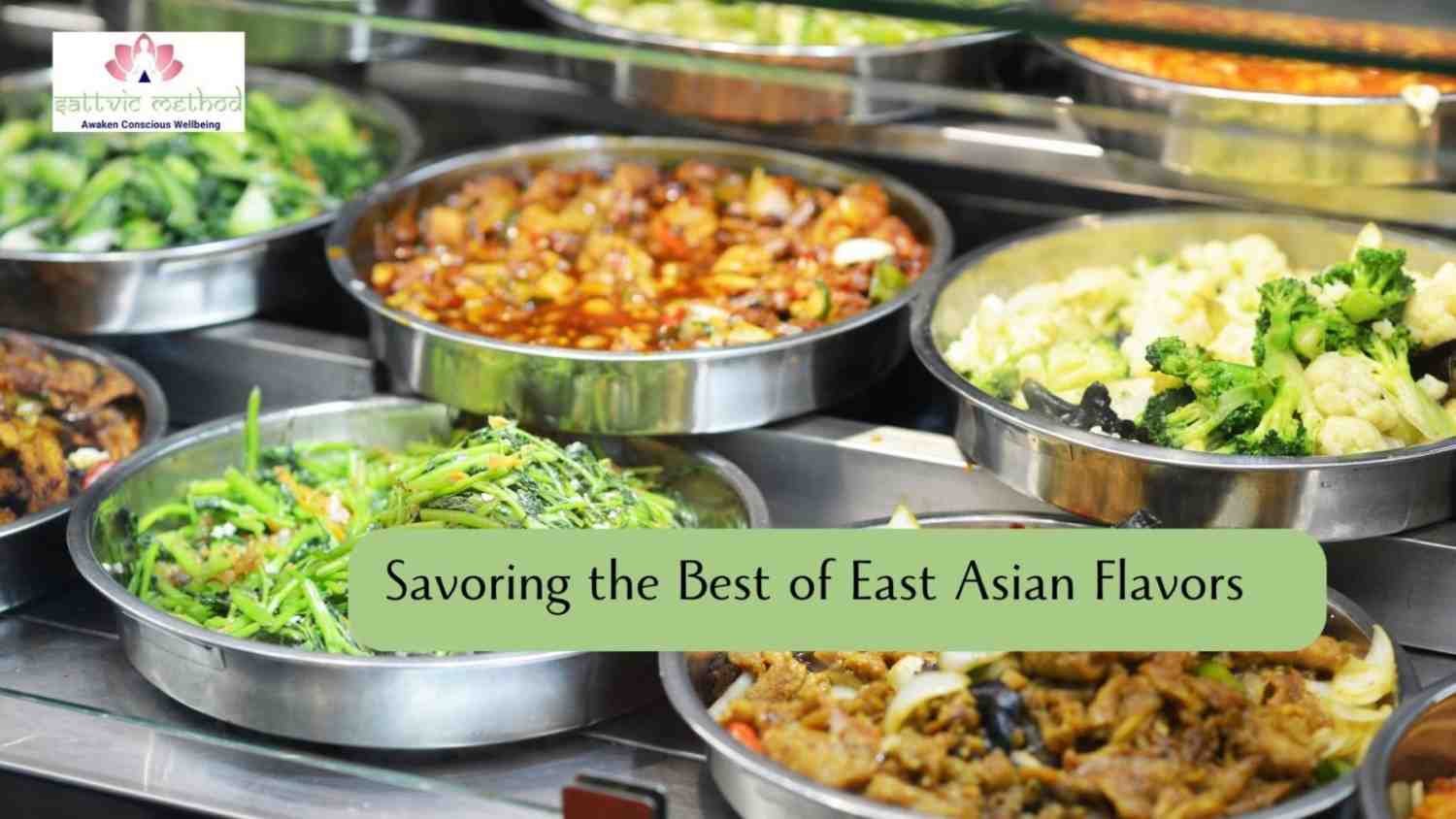Delve into the world of East Asian cuisine as we embark on a flavorful journey into the realm of vegetarian delicacies. From the bustling streets of Tokyo to the vibrant markets of Bangkok, East Asia boasts a rich culinary heritage that caters to every palate. In this article, we will explore the diverse flavors and textures that make vegetarian cuisine in this region a true delight.
Whether you’re a seasoned vegetarian or simply looking to incorporate more plant-based options into your diet, East Asia offers a plethora of delectable dishes that will leave you craving for more. From mouthwatering dumplings and fragrant curries to savory stir-fries and refreshing salads, the vegetarian options are as diverse as the cultures themselves.
Join us as we uncover the secrets behind some of the most beloved vegetarian dishes in East Asia, highlighting the unique combination of ingredients and techniques that bring them to life. Get ready to savor the best of East Asian flavors and discover new and exciting ways to enjoy vegetarian cuisine.
Exploring vegetarian options in East Asian cuisine
East Asian cuisine is a treasure trove of flavors, textures, and aromas, and it offers a wide range of vegetarian options that are as rich and varied as the region’s cultural tapestry. Countries like China, Japan, Korea, and Thailand boast unique culinary traditions that incorporate vegetables, grains, and legumes in innovative ways. The emphasis on fresh, seasonal ingredients not only enhances taste but also celebrates the natural beauty of plant-based foods. As vegetarianism gains popularity worldwide, East Asian culinary traditions provide an excellent foundation for delicious, meat-free meals.
In many East Asian cultures, vegetarianism is deeply rooted in philosophical and spiritual beliefs. For instance, Buddhism has a significant influence on Asian dietary practices, promoting a lifestyle that values compassion towards all living beings. This has led to the development of various vegetarian dishes that do not compromise on flavor or satisfaction. From the spicy and vibrant dishes of Thailand to the delicate and refined meals of Japan, vegetarian options are plentiful and reflect the region’s culinary diversity.
Moreover, the adaptability of East Asian cuisine allows for creative variations of traditional dishes by substituting meat with plant-based ingredients. This flexibility means that whether you’re dining out or cooking at home, you can easily find or create vegetarian options that resonate with your taste preferences. From hearty soups to vibrant stir-fries, the vegetarian offerings in East Asian cuisine are not only satisfying but also a celebration of the vibrant flavors that each country has to offer.
Traditional vegetarian dishes in East Asian cuisine
When it comes to traditional vegetarian dishes, East Asia is home to an impressive array of options that cater to diverse palates. In China, for example, dishes like Buddha’s Delight (Luohan Zhai) are popular during festivals and are composed of a medley of vegetables, tofu, and sometimes, vermicelli noodles, all stir-fried with an assortment of spices. This dish is not only visually appealing but also brimming with flavors and textures that make it a delight for any vegetarian diner. The use of soy sauce, sesame oil, and fresh herbs further elevates the dish, showcasing the complexity of Chinese vegetarian cooking.
In #Japan, one cannot overlook the exquisite art of vegetarian cuisine, particularly in the form of Shojin Ryori, a traditional Buddhist cuisine. This culinary style emphasizes simplicity and seasonality, often featuring ingredients like tofu, seaweed, and seasonal vegetables prepared in a manner that highlights their natural flavors. Dishes such as Nasu Dengaku (miso-glazed eggplant) or Yuba (tofu skin) demonstrate the careful balance of taste and aesthetics that characterize Japanese cooking. Each meal is not just about nourishment but also about appreciating the beauty of the ingredients, making it a truly immersive experience.
#Korean cuisine also offers a wealth of vegetarian options, with dishes like Kimchi Jjigae (kimchi stew) often made without meat. The diverse range of banchan (side dishes) found in a traditional Korean meal includes various pickled vegetables, savory pancakes, and stir-fried greens, all of which highlight the country’s love for fermentation and bold flavors. The use of gochujang (fermented red chili paste) and doenjang (fermented soybean paste) adds depth to vegetarian dishes, ensuring that every bite is packed with flavor and satisfaction.
Fusion vegetarian dishes in East Asian cuisine
As the world becomes increasingly interconnected, fusion cuisine has emerged as a vibrant and exciting culinary trend. East Asian vegetarian dishes are no exception to this phenomenon, with chefs and home cooks experimenting to create unique fusions that blend traditional flavors with modern twists. One popular example is the incorporation of East Asian ingredients into Western-style dishes. For instance, you might find a sushi burrito that combines the freshness of sushi with the portability of a burrito, filled with colorful vegetables, avocado, and spicy tofu.
In addition to sushi burritos, fusion dishes like Thai green curry pasta have gained popularity, merging the aromatic flavors of Thai cuisine with the comfort of Italian pasta. The creamy coconut milk and vibrant green curry paste complement al dente noodles beautifully, creating a dish that is both comforting and exotic. These innovative combinations reflect how traditional East Asian flavors can transcend cultural boundaries, making them accessible and appealing to a broader audience.
Moreover, the rise of plant-based diets has also led to the emergence of numerous fusion restaurants that specialize in vegetarian options. These establishments often take classic East Asian dishes and reinterpret them using plant-based ingredients, creating meals that are both familiar and novel. Examples include jackfruit bao buns, which have become a popular street food item, and vegan kimchi tacos, merging the bold flavors of Korean cuisine with the beloved Mexican staple. Such fusion dishes not only satisfy cravings but also encourage diners to explore the versatility of vegetarian cuisine.
Popular ingredients in East Asian vegetarian cooking
The foundation of East Asian vegetarian cuisine lies in its rich palette of ingredients, each adding distinct flavors and textures to dishes. Vegetables such as bok choy, napa cabbage, and shiitake mushrooms are staples in many recipes, thanks to their availability and versatile nature. Bok choy, with its crisp texture and mild flavor, can be stir-fried, steamed, or added to soups, while napa cabbage is often the star of pickled dishes like kimchi. Shiitake mushrooms, known for their earthy umami flavor, are a favorite in stir-fries and broths, enhancing the overall depth of vegetarian meals.
Legumes and soy products also play a crucial role in East Asian vegetarian cooking. Tofu, in particular, is celebrated for its adaptability, soaking up flavors from sauces and seasonings. From silken tofu in desserts to firm tofu in stir-fries, this protein-rich ingredient is a key component of many dishes. Tempeh, a fermented soybean product, is gaining traction in East Asian cuisines as a nutritious meat alternative, often marinated and grilled or stir-fried to create satisfying meals.
Herbs and spices are essential for elevating the flavors of vegetarian dishes in East Asia. Fresh ingredients like cilantro, Thai basil, and green onions are commonly used to add brightness and freshness to meals. Additionally, sauces such as soy sauce, hoisin sauce, and chili oil provide depth and complexity to vegetarian recipes, allowing for a wide range of flavor profiles. The harmonious blend of these ingredients not only enhances the taste but also ensures that vegetarian dishes are as exciting and satisfying as their meat-based counterparts.
Cooking techniques in East Asian vegetarian cuisine
The cooking techniques employed in East Asian vegetarian cuisine play a significant role in the preparation and presentation of dishes. Stir-frying is perhaps one of the most iconic methods, allowing for quick cooking while preserving the vibrant colors and nutrients of vegetables. This technique often involves high heat, minimal oil, and quick movements, creating a dish that is flavorful and aesthetically pleasing. Stir-fried dishes like vegetable chow mein or tofu stir-fry are perfect examples of how this method brings out the best in fresh ingredients.
Steaming is another popular technique in East Asian cooking, particularly for vegetarian dumplings and buns. This method retains the moisture and nutrients of the ingredients while allowing the natural flavors to shine. Steamed vegetable dumplings filled with a mixture of mushrooms, cabbage, and carrots are a beloved dish that showcases the delicate balance of textures. The subtle flavors meld together, resulting in a satisfying bite that is both light and delectable.
Fermentation is a hallmark of East Asian cuisine, contributing to the depth of flavor in many vegetarian dishes. Techniques such as pickling vegetables or making kimchi involve the use of salt and time to develop complex flavors that elevate the overall dish. Fermented foods not only add a unique tang but also provide health benefits, making them a popular choice in East Asian diets. Whether it’s a side of tangy kimchi or a bowl of pickled cucumbers, these fermented elements play a vital role in creating a well-rounded meal.
Health benefits of East Asian vegetarian cuisine
The health benefits of East Asian vegetarian cuisine are numerous, thanks to its emphasis on fresh ingredients, whole grains, and balanced flavors. One of the most significant advantages is the abundance of vegetables and legumes, which are rich in vitamins, minerals, and antioxidants. These nutrients contribute to overall health and well-being, helping to reduce the risk of chronic diseases such as heart disease, diabetes, and certain cancers. By incorporating a variety of colorful vegetables into meals, practitioners of vegetarian diets can ensure they receive a wide range of nutrients essential for good health.
Moreover, many East Asian dishes are low in saturated fats and high in fiber, which can aid in digestion and contribute to a healthy weight. The use of whole grains such as brown rice, quinoa, and barley in place of refined grains further enhances the nutritional profile of meals. These grains provide sustained energy and are often packed with essential nutrients, making them a smart choice for those looking to maintain a balanced diet.
Additionally, the focus on fermented foods in East Asian cuisine offers numerous probiotic benefits, promoting gut health and immune function. Fermented ingredients like miso, kimchi, and tempeh not only enhance flavor but also support the growth of beneficial bacteria in the digestive system. This can lead to improved digestion, better nutrient absorption, and overall enhanced health. With the combination of fresh ingredients, balanced flavors, and health-promoting techniques, East Asian vegetarian cuisine offers a delicious and nourishing way to embrace a plant-based lifestyle.
East Asian vegetarian restaurants and food markets
As the demand for vegetarian cuisine continues to grow, many East Asian cities have embraced this trend by establishing a vibrant array of vegetarian restaurants and food markets. These establishments often feature menus that celebrate the rich culinary traditions of the region while offering innovative plant-based alternatives. In cities like Tokyo, Bangkok, and Seoul, vegetarian and vegan restaurants are popping up, serving dishes that cater to both locals and tourists alike. Diners can enjoy a wide range of options, from traditional Buddhist cuisine to modern fusion dishes that highlight the versatility of East Asian flavors.
Food markets are another treasure trove for vegetarian enthusiasts, offering a plethora of fresh produce, spices, and specialty ingredients. Markets such as #Tokyo’s Tsukiji Outer Market or Bangkok’s Chatuchak Market are famous for their diverse offerings, where you can find everything from exotic fruits to handmade tofu. These markets not only provide the opportunity to sample delicious street food but also allow shoppers to purchase ingredients to recreate their favorite dishes at home. Engaging with local vendors and learning about their products can deepen one’s appreciation for the flavors of East Asia.
Moreover, many of these restaurants and markets prioritize sustainability and ethical sourcing, making them appealing choices for environmentally conscious diners. By focusing on local, seasonal ingredients, they reduce their carbon footprint while supporting local farmers and communities. This commitment to sustainability is reflected in the care and attention that goes into preparing each dish, ensuring that diners experience the best of East Asian vegetarian cuisine in a responsible manner.
East Asian vegetarian recipes to try at home
For those inspired to bring the vibrant flavors of East Asian vegetarian cuisine into their own kitchens, there are countless recipes to explore. One popular dish is Mapo #Tofu, a spicy Sichuan dish that can easily be adapted to be vegetarian by using a plant-based ground meat alternative. The combination of silken tofu, fermented black beans, and chili oil creates a mouthwatering meal that is sure to impress. Served over steamed rice, it is a comforting dish that showcases the bold flavors characteristic of #Chinese cuisine.
Another delightful recipe to try is #Thai Green Curry with vegetables. This fragrant dish features a homemade green curry paste made from fresh herbs such as cilantro, basil, and green chilies, blended with coconut milk and an assortment of seasonal vegetables. The result is a creamy, aromatic curry that is both satisfying and nourishing. Serve it with jasmine rice for a complete meal that transports you straight to the bustling streets of Thailand.
For a light and refreshing option, consider making a Japanese-inspired salad with sesame dressing. This simple yet flavorful dish combines mixed greens, shredded carrots, and sliced cucumbers, topped with a sesame soy dressing. The nutty flavor of sesame oil pairs beautifully with the crisp vegetables, creating a perfect side dish or light lunch. This recipe captures the essence of Japanese cuisine, emphasizing fresh ingredients and balanced flavors.
Embracing the flavors of East Asian vegetarian cuisine
As we conclude our flavorful journey through the world of East Asian vegetarian cuisine, it’s clear that this region offers a wealth of delicious and diverse options for plant-based eaters. From traditional dishes steeped in rich cultural heritage to innovative fusion creations, the flavors of East Asia are both captivating and satisfying. The emphasis on fresh ingredients, unique cooking techniques, and the deep-rooted philosophies surrounding vegetarianism make this cuisine a remarkable experience for anyone looking to explore the world of plant-based eating.
The culinary traditions of East Asia provide endless inspiration for those seeking to incorporate more vegetarian meals into their diets. Whether dining at a local restaurant, shopping at a bustling food market, or trying your hand at cooking at home, there are numerous ways to savor the vibrant flavors and textures that define this cuisine.
Ultimately, embracing East Asian vegetarian cuisine is not just about the food itself; it’s about the connection to culture, community, and sustainability. By exploring these delicious dishes and ingredients, we can deepen our appreciation for the culinary arts while nourishing our bodies and minds. So, let the flavors of East Asia inspire your culinary adventures and invite you to savor the best of vegetarian delicacies.




